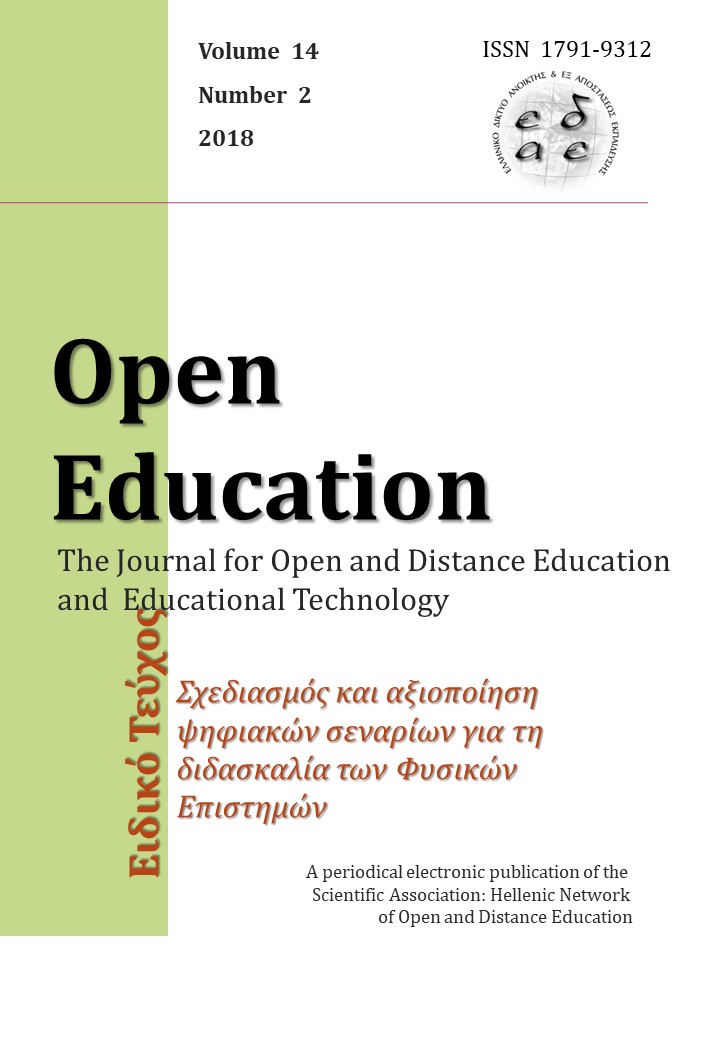Application of Digital Teaching Scenarios for High School produced on the AESOP platform
Abstract
At international as well as at national level, a number of learning subjects has been developed for educational purposes. In the modern digital world there is plenty of digital material that could be used in various ways in education and teaching. Therefore, the teacher’s role shifts from providing knowledge, to designing the teaching process. Appropriate educational planning is required, which will link the available material with appropriate teaching practices and theoretical approaches. Research has demonstrated that educational design should aim for the development, organization and use of digital learning scenarios, that should be structured on the basis of internationally recognized standards, in order to achieve easier and more direct use by the educational community. The Aesopos platform, which is available in the Greek educational community, is an online design and hosting environment for eclasses that have been structured and organized as digital interactive teaching scenarios. In this study, we present our experience emanating from the use of digital scenarios produced on the Aesopos platform, during the school years 2016-2017 and 2017-2018, in order to ascertain their use in the classroom and propose alternative approaches or improvements from the experience that was gathered. In those scenarios, the starting points of each teaching sequence were the students’ pre-existing knowledge as well as their common misconceptions, in the courses of Biology and Geography-Geology, which either hinder or prohibit the teaching sequence itself. In any constructive model of teaching, misconceptions play a key role in educational planning since they delimit both the teaching process and the planning of appropriate activities. We chose to employ lesson plans, first because we wanted to introduce an alternative way of approaching the course that would maintain a high level of students' interest, and second because the lesson plans encompassed original educational material that was very well organized, as a result of an effective educational strategy.
The scenarios were used in an experimental lower high school, where children have an enhanced interest in learning and respond positively to activities and assignments that may exhibit a considerable level of difficulty. In the first grade, regarding the lesson of Geography, we employed the following scenarios: 'Temperature - Winds - Rains - Climate”, “Water as element and as a ghost”, “Geological time and Geological history of Earth”, whereas regarding the lesson of Biology we employed the scenario “The Circulatory system”. In the second grade, regarding the Biology lesson, we employed the following scenario: "The Truth About Bacteria". In the third grade, regarding the Biology lesson, we employed the following scenario: 'The organization levels for multi-cellular organisms - Animal tissues”. Our involvement with Aesopos’s lesson plans, as an alternative way of deploying our teaching, stems from the vision that we have about education in general, and schools in particular. The educational practice, i.e. the context within which the whole process takes place, often invalidates any prior design. Class dynamics may topple or even eliminate even the best organized lesson plans. We have established that the structure and organization of digital scenarios allow us to make adjustments or selective additions, in order to be able to adapt to the specific class’ requirements. Therefore, in numerous cases we chose either not to implement certain phases or to modify their proposed order of execution (or even to bring a certain phase forward, as a prerequisite for further teaching), while in other cases we either did not provide specific answers or provided collaborative/group answers to the supplied worksheets. In certain cases where an internet-based platform had to be employed, students were not familiar with that platform, and there had been no prior provisions, within the lesson plan, for them to familiarize themselves with it. The scenarios allow us to highlight and manage students’ misconceptions. Our findings, regarding those misconceptions, conform to similar findings from the literature. Further to the evaluation of the written assignments, it was established that the students had difficulty with understanding newspaper articles which featured scientific terms, thus finding it difficult to answer all the questions. We believe that a reassessment of the available external resources is required, and that material containing terms that are compatible with the students’ cognitive and mental capabilities should be incorporated. Throughout all the scenarios, the resources that were employed were a personal computer, the world-wide-web, a projector, and a screen. Almost all schools already own such infrastructure. Therefore, it is our belief that, insofar as resources are concerned, scenarios can easily be incorporated into the teaching process
Article Details
- How to Cite
-
Πανδή Μ., & Στασινάκης Π. (2018). Application of Digital Teaching Scenarios for High School produced on the AESOP platform. Open Education: The Journal for Open and Distance Education and Educational Technology, 14(2), 124–141. https://doi.org/10.12681/jode.19010
- Issue
- Vol. 14 No. 2 (2018)
- Section
- Section 1
Copyright Notice
Authors who publish with this journal agree to the following terms:
Authors retain copyright and grant the journal right of first publication with the work simultaneously licensed under a Creative Commons Attribution Non-Commercial License that allows others to share the work with an acknowledgement of the work's authorship and initial publication in this journal.
Authors are able to enter into separate, additional contractual arrangements for the non-exclusive distribution of the journal's published version of the work (e.g. post it to an institutional repository or publish it in a book), with an acknowledgement of its initial publication in this journal.
Authors are permitted and encouraged to post their work online (preferably in institutional repositories or on their website) prior to and during the submission process, as it can lead to productive exchanges, as well as earlier and greater citation of published work.



